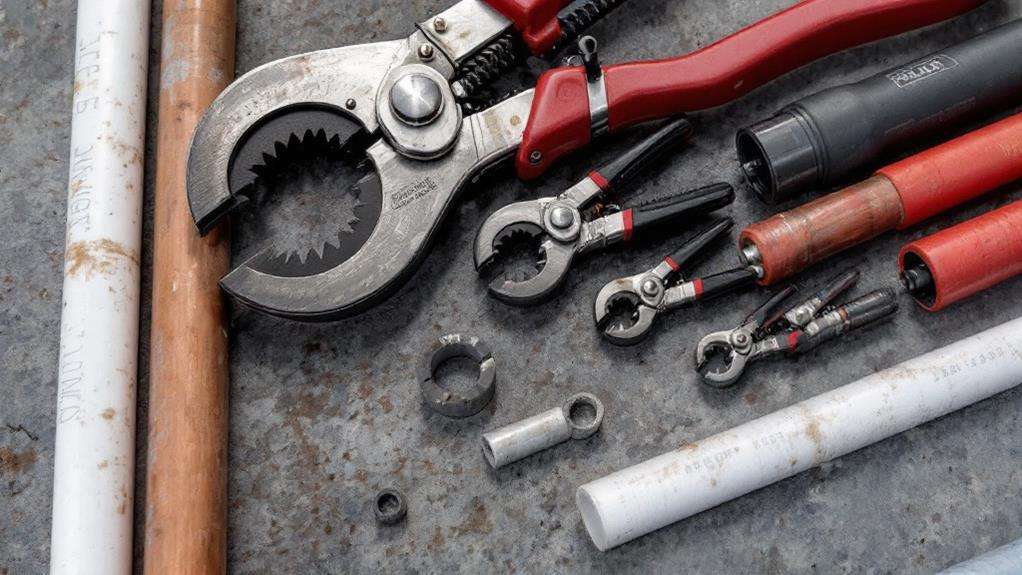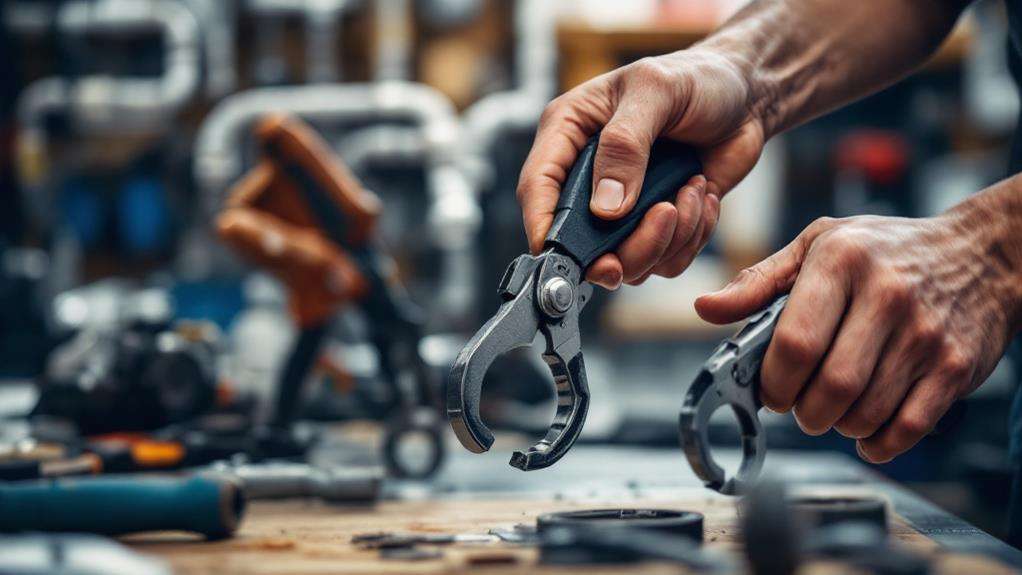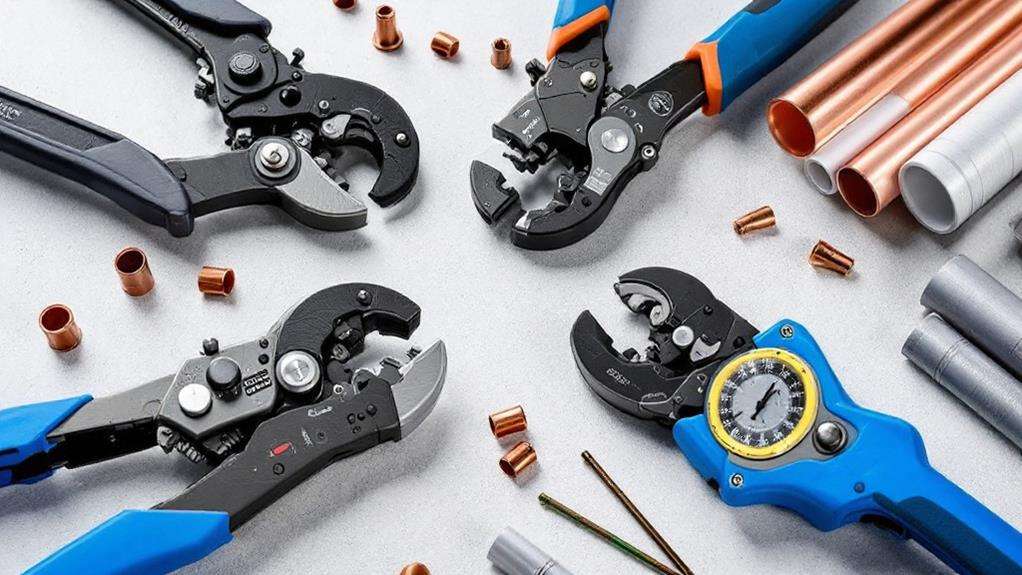How to Select the Right Pipe Cutter for Your Plumbing Project
To select the right pipe cutter for your plumbing project, consider the type of pipe you're working with and match it to the appropriate cutter. Copper tubes need copper cutters, while steel pipes require steel cutters. Check the cutting capacity to guarantee it can handle your pipe's diameter. Consider power options: manual for simple jobs, electric for faster work. Look for ergonomic designs with comfortable grips for ease of use. Choose cutters with high-quality, replaceable blades for longevity. Don't forget to factor in additional features like integrated reamers or textured grips. Proper tool selection and maintenance will make your plumbing tasks notably easier and more efficient.
Types of Pipe Cutters
Pipe cutters come in various types, each designed for specific materials and applications. When you're choosing a cutting tool for your plumbing project, it is crucial to match the cutter to the pipe material you're working with.
For copper pipes, you'll want to use a Copper Tube Cutter. These versatile tools can handle both rigid and flexible copper tubing. If you're dealing with iron or steel pipes, opt for a Steel Pipe Cutter. Its stronger cutting wheel is built to tackle tougher materials.
When you're working with clay, concrete, or cast-iron pipes, a Cast Iron Snap Cutter is your best choice. This chain-type cutter is specifically designed for these heavy-duty materials. For PVC pipes up to 2 inches in diameter, a PVC Tube Cutter with a ratcheting mechanism will make quick work of your cuts.
If you're dealing with softer materials like CPVC or PEX tubing, you'll find CPVC and PEX Cutters particularly useful. These tools can cut through soft tubing with just one squeeze of the handle, making your job faster and easier.
Material Compatibility
When selecting a pipe cutter, it is crucial to keep in mind material compatibility. Different types of pipes require specific pipe cutters designed to handle their unique properties. For copper pipes, you'll want to use a copper tube cutter with a thinner cutting wheel, as it is tailored for the softer walls of these pipes. If you're working with steel or iron pipes, opt for a steel pipe cutter featuring a thicker, stronger cutting wheel to effectively cut through the harder material.
For cast iron, clay, or concrete pipes, a cast iron snap cutter with a chain-type design is your best option. These cutters are specially designed to manage the unique challenges posed by these materials. When dealing with plastic pipes like PVC, CPVC, or PEX, you'll need a cutter that employs a ratcheting mechanism. This type of cutter is efficient for cutting soft plastic tubing and guarantees clean, precise cuts.
Cutting Capacity

One of the most critical factors to evaluate when choosing a pipe cutter is its cutting capacity. You'll need to examine the minimum and maximum pipe diameters the cutter can handle to confirm it's best suited for your project. Different pipe cutters are designed to accommodate specific sizes, so it's crucial to match the tool's capacity with the pipes you'll be working on.
For larger diameter pipes, you'll want to opt for a more heavy-duty cutter with a stronger cutting wheel. These tools can handle the increased thickness and resistance of bigger pipes. On the other hand, if you're dealing with smaller pipes in tight spaces, a compact and portable pipe cutter might be your best bet.
When analyzing cutting capacity, don't forget to factor in the material of the pipes you'll be cutting. Some cutters are designed specifically for certain materials, while others offer versatility across different pipe types. Investing in a pipe cutter that can handle a range of sizes and materials may be more cost-effective in the long run, especially if you anticipate working on various plumbing projects in the future.
Power Source Options
After considering the cutting capacity, you'll need to think about the power source for your pipe cutter. The best option depends on your specific project requirements and work environment. When choosing a power source, consider the size, material, and quantity of pipes you'll be cutting, as well as the available power infrastructure at your work site.
Manual pipe cutters are the most cost-effective and widely used cutting tools. They rely on your physical effort to operate and can be used to cut PVC and other materials. If you're working on smaller projects or have limited power access, these may be your best bet.
For larger pipes or more frequent cutting, electric pipe cutters offer motor-driven power for faster and more efficient operation. Pneumatic pipe cutters, which use compressed air, are suitable for heavy-duty industrial applications. If you're dealing with extremely thick or tough pipes, hydraulic pipe cutters provide immense cutting force through fluid-powered mechanisms.
Ergonomics and Comfort

The comfort of your hands can make or break a plumbing project. When selecting a pipe cutter, prioritize ergonomic features that reduce hand strain and fatigue during prolonged use. Look for models with padded, textured handles that provide a secure grip and minimize discomfort.
Spring-loaded and ratcheting mechanisms are excellent additions to pipe cutters, as they greatly reduce the physical effort required for clean, precise cuts. Choose a well-balanced, compact design that enhances control and maneuverability, especially when working in tight spaces.
Consider these factors when evaluating pipe cutters for ergonomics and comfort:
- Weight and portability: Opt for lightweight cutters that are easy to handle and transport.
- Adjustable grips: Accommodate the cutter to your hand size and preferences.
- Handle shape: Select a design that feels comfortable and natural in your hand.
- Overall balance: Choose a cutter that distributes weight evenly for better control.
Blade Quality and Replaceability
While ergonomics and comfort are vital for ease of use, a pipe cutter's effectiveness ultimately depends on its blade. When selecting a pipe cutter, make sure to opt for high-quality blades made of heat-treated steel that resist corrosion and rust. These blades can be serrated, flat, or circular, depending on the specific requirements of your project.
Keep in mind that the blade type should be appropriate for the material and thickness of the pipes you'll be cutting. This guarantees clean, precise cuts every time. Research the available blade materials and options to choose the right cutter for your plumbing project.
Replaceable blades are a significant feature to consider. They extend the lifespan of your pipe cutter by allowing you to swap out worn-out blades instead of replacing the entire tool. This not only saves you money in the long run but also ensures your cutter remains effective over time.
When using pipe cutters, wear appropriate safety gear and follow proper techniques. Remember that blade quality and replaceability are key factors in determining the durability and longevity of your pipe cutter, so invest wisely in a tool that meets your specific needs.
Additional Features to Consider

When selecting a pipe cutter, you'll want to ponder several additional features that can enhance its functionality and ease of use. One key feature to look for is an integrated reamer, which can provide a clean, smooth cut on the pipe's interior. This feature guarantees that your cuts are not only precise but also ready for immediate use.
Choosing the right pipe cutter also means considering its exterior design. The best pipe cutters often have a textured grip, making them easy to use and reducing the risk of slippage during operation. This feature is especially important when working in tight spaces or with wet hands.
Four more features to keep in mind when selecting a pipe cutter:
- Cutting speed: Faster cutters can cut through pipes more efficiently
- Blade quality: High-quality blades ensure cleaner cuts and longer tool life
- Durability: Look for sturdy construction and a manufacturer's warranty
- Blade replaceability: Easy blade swapping extends the tool's lifespan
Maintenance and Longevity
Longevity of your pipe cutter depends heavily on proper maintenance. To guarantee your tool lasts longer and performs ideally, you'll need to establish a regular cleaning and care routine. After each use, wipe down your cutter to remove any debris or residue that could affect its performance.
Lubrication is key to maintaining smooth operation. Apply lubricant to the cutter's moving parts, especially the hinge and cutting wheel, to prevent premature wear. This simple step can extensively extend your tool's lifespan.
Don't overlook the importance of blade maintenance. Regularly inspect your cutting blades for signs of wear or damage. When they become dull or chipped, replace them promptly to ensure clean, burr-free cuts and protect the cutter body from unnecessary stress.
Proper storage is essential for protecting your pipe cutter when it's not in use. Keep it in a protective case or box to shield it from dust, debris, and physical damage. This precaution will help maintain the tool's accuracy and cutting performance.
Lastly, follow the manufacturer's recommended maintenance procedures, such as adjusting tension or replacing seals. These steps will help preserve your pipe cutter's accuracy and durability over time.

